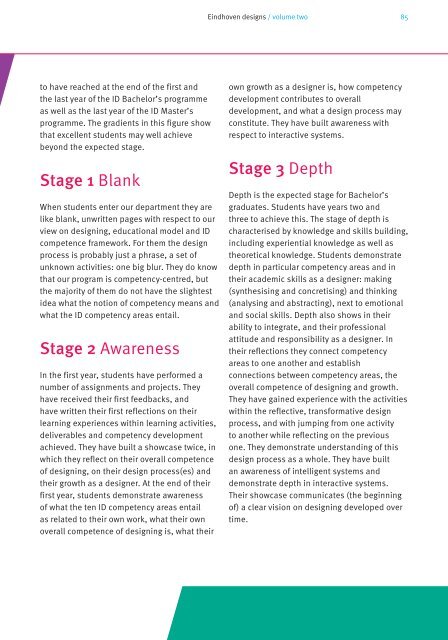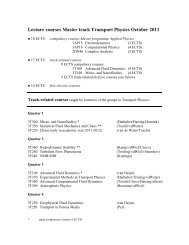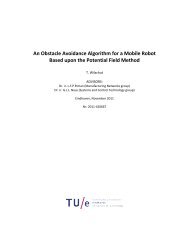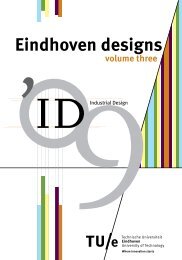Education guide 'Eindhoven designs' - Technische Universiteit ...
Education guide 'Eindhoven designs' - Technische Universiteit ...
Education guide 'Eindhoven designs' - Technische Universiteit ...
You also want an ePaper? Increase the reach of your titles
YUMPU automatically turns print PDFs into web optimized ePapers that Google loves.
Eindhoven designs / volume two 85<br />
to have reached at the end of the first and<br />
the last year of the ID Bachelor’s programme<br />
as well as the last year of the ID Master’s<br />
programme. The gradients in this figure show<br />
that excellent students may well achieve<br />
beyond the expected stage.<br />
Stage 1 Blank<br />
When students enter our department they are<br />
like blank, unwritten pages with respect to our<br />
view on designing, educational model and ID<br />
competence framework. For them the design<br />
process is probably just a phrase, a set of<br />
unknown activities: one big blur. They do know<br />
that our program is competency-centred, but<br />
the majority of them do not have the slightest<br />
idea what the notion of competency means and<br />
what the ID competency areas entail.<br />
Stage 2 Awareness<br />
In the first year, students have performed a<br />
number of assignments and projects. They<br />
have received their first feedbacks, and<br />
have written their first reflections on their<br />
learning experiences within learning activities,<br />
deliverables and competency development<br />
achieved. They have built a showcase twice, in<br />
which they reflect on their overall competence<br />
of designing, on their design process(es) and<br />
their growth as a designer. At the end of their<br />
first year, students demonstrate awareness<br />
of what the ten ID competency areas entail<br />
as related to their own work, what their own<br />
overall competence of designing is, what their<br />
own growth as a designer is, how competency<br />
development contributes to overall<br />
development, and what a design process may<br />
constitute. They have built awareness with<br />
respect to interactive systems.<br />
Stage 3 Depth<br />
Depth is the expected stage for Bachelor’s<br />
graduates. Students have years two and<br />
three to achieve this. The stage of depth is<br />
characterised by knowledge and skills building,<br />
including experiential knowledge as well as<br />
theoretical knowledge. Students demonstrate<br />
depth in particular competency areas and in<br />
their academic skills as a designer: making<br />
(synthesising and concretising) and thinking<br />
(analysing and abstracting), next to emotional<br />
and social skills. Depth also shows in their<br />
ability to integrate, and their professional<br />
attitude and responsibility as a designer. In<br />
their reflections they connect competency<br />
areas to one another and establish<br />
connections between competency areas, the<br />
overall competence of designing and growth.<br />
They have gained experience with the activities<br />
within the reflective, transformative design<br />
process, and with jumping from one activity<br />
to another while reflecting on the previous<br />
one. They demonstrate understanding of this<br />
design process as a whole. They have built<br />
an awareness of intelligent systems and<br />
demonstrate depth in interactive systems.<br />
Their showcase communicates (the beginning<br />
of) a clear vision on designing developed over<br />
time.

















